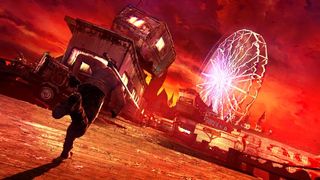DmC: Devil May Cry hands-on - 6 ways it absolutely improves on the original series
It's great, whether you like it or not
DmC, Ninja Theory's reboot of Devil May Cry, has been a controversial beast from the off. In fact it's fair to say that a very loud group of the series' fans have not been happy about it at all. Some have been doubtful of the British developer's ability to deliver the polish the series requires. Some have seemed unconvinced that any western developer could successfully pick up such a demanding and quintissentially Japanese action series. Many have just used the new Dante's hair colour as shorthand with which to vent every possibly fear and paranoia under the sun.
But paranoia and assumptions only hold sway for so long. What will ultimately decide DmC's quality is nothing more or less than hands-on time with the game itself. We've now had that. A lot of it. A whole day of it. And, like it or not, DmC so far looks very, very good indeed. In some ways it's actually way ahead of the original games. Allow us to explain.
1. The combat is more accessible, but no less deep
Right, the major point of contention. Combat has changed a bit. But before you start worrying that something has been lost in translation through the series’ move to the west, know one simple fact. It’s still brilliant. In fact all of the changes seem to have been made with the precise aim of allowing you far more access to Devil May Cry’s brilliant bits than ever before.

This is a more accessible game in the literal sense, not the dirty, casual-baiting Super Wii Party Family Sports Collection meaning of the word. Dante can still launch, juggle, evade, grapple and air-combo with just as much precision as before, and the ability to do so is still utterly demanded. It’s just that the ability to execute all of the above now feels far more immediately to hand.
Separate horizontal and vertical melee swipe inputs make launches, down-strikes, juggles and crowd control much more immediate and instinctive. The ability to equip two different melee weapons at a time, activating each for as long as the left or right trigger is held, makes tactical switch-ups and extravagantly varied combos second nature in no time. Ditto the use of trigger modifiers for Dante’s two complimentary long-range grabs, one of which pulls enemies towards him, the other of which zips him towards them. The system seriously empowers the air-game, giving it a freer, rangier sense of creative spatial control than before, creating a feeling of almost pulling apart and reconfiguring the battle from within.

DmC is about ease of use, but certainly not ease of challenge. It’s not long at all before the game starts demanding extremely creative use of its toolset, turning fights into high-speed puzzles of logic and dexterity. It does so with an immense sense of confidence, both in the robustness of its own bag of tricks to handle such challenges, and in the player’s ability to use those tools to their full potential. DmC is that ideal blend of accessibility and complexity. It wants to give you every facility to be cool and badass, but it also trusts you hold up your part of the bargain too, by putting in the creative effort.
2. Visually, it's off the chart
You simply have not played a AAA action game with looks and atmosphere like DmC. In terms of production design, this game has a personality all of its own. Gone is any sense of the old series’ clichéd gothic fantasy, the game’s every location and monster now instead infused with a fizzing urban decay and stark, lunatic brutality. It’s a modern world very much like our own, but pitched deliberately just off-centre when the demonic crap hits the fan, in order to be all the more jarring through its ever-so-slight sense of wrongness and alienation.
Sign up to the GamesRadar+ Newsletter
Weekly digests, tales from the communities you love, and more

There’s a far more affecting horror vibe this time around too, with creature designs seeming to take visual cues from the full gamut of dark surrealist influences. DmC’s world is (literally) alive with an angry sense of malice, its sentient supernatural environments spewing swathes of hazards and enemies straight out of Bosch, Barker, Escher and Cunningham.
That’s a massive jump from the old games’ visual approach. A hulking great suit of armour might be intimidating when stomping around a gloomy castle, but through cliche it also feels right. Reassuring even. A stitched-together biomechanical demon skittering around a swirling LSD-infused funfair? Far less comfortable. And that’s before we even get onto the really weird stuff. Speaking of which…

Fallout 4's big next-gen patch isn't going over well, especially on PC: "I had very low expectations but this is MUCH less than I expected"

30 years after he created Hellboy, Mike Mignola is creating a whole new folklore-inspired universe

Destiny 2 is un-sunsetting every gun in the MMO with The Final Shape's massive Power changes – but Bungie says "we have no recovery mechanism" for deleted ones
Most Popular




